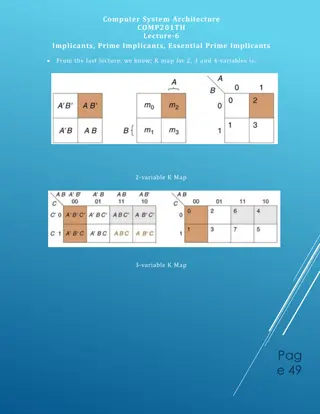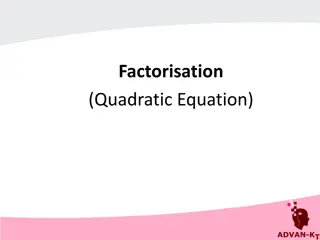Understanding Prime Factorization for Prime and Composite Numbers
Learn about prime and composite numbers, prime factorization, and how to identify them using examples. Discover the concept of factors, prime numbers, composite numbers, and prime factors through this educational presentation. Explore how every composite number can be expressed as a product of prime numbers, and understand the significance of prime factorization in mathematics education.
Download Presentation

Please find below an Image/Link to download the presentation.
The content on the website is provided AS IS for your information and personal use only. It may not be sold, licensed, or shared on other websites without obtaining consent from the author. Download presentation by click this link. If you encounter any issues during the download, it is possible that the publisher has removed the file from their server.
E N D
Presentation Transcript
Prime Factorization by Dr. Emerlina C. Binuya every composite number expressed as a product of a prime number.
Concept Summary: Prime A whole number that has exactly two factors, 1 and the number itself. 11, 13, 25 Composite A number greater than 1 with more than two factors. 6, 10, 18 Neither prime nor composite 1 has only one factor. O has an infinite number or factors. 0, 1
.Identify Prime and composite, or neither 28: The factors of 28 are 1 and 28, 2 and 14, and 4 and 7. Since 28 has more than two factors, it is a composite number. 11: The factors of 11 are 1 and 11. Since there are exactly two factors, 1 and the number itself, 11 is a prime number.
Remember Factor: when two or more numbers are multiplied, each number is called a factor of the product. Prime Number: a whole number that has exactly two unique factors, 1 and the number itself. Composite number: a number greater than 1 with more than two factors.
Prime Numbers and Prime Factorization Every Composite number can be written as a product of prime numbers 6 = 2 x 3 8 = 2 x 2 x 2 12= 2 x 2 x 3
Prime Factors Factors that are prime numbers are called prime factors. You can use Factor Tree to find prime factors. This one shows the prime factors of 50 50 2 25 50=2 x 5 x 5 is the prime factorization of 50. 5 5
Hope you enjoy the Lesson! Have a nice day to all of you!!!!!!!
This powerpoint was kindly donated to www.worldofteaching.com http://www.worldofteaching.com is home to over a thousand powerpoints submitted by teachers. This is a completely free site and requires no registration. Please visit and I hope it will help in your teaching.























